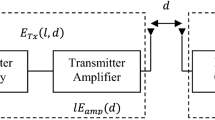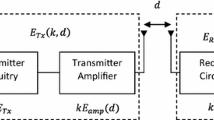Abstract
Wireless sensor network (WSN) consists of densely distributed nodes that are deployed to observe and react to events within the sensor field. In WSNs, energy management and network lifetime optimization are major issues in the designing of routing protocols. Clustering is an efficient data gathering technique that effectively reduces the energy consumption by organizing nodes into groups. However, in clustering protocols, cluster heads (CHs) bear additional load for coordinating various activities within the cluster. Improper selection of CHs causes increased energy consumption and also degrades the performance of WSN. Therefore, proper CH selection and their load balancing using efficient routing protocol is a critical aspect for the long run operation of WSN. Clustering a network with proper load balancing is an NP-hard problem. To solve such problems having vast search area, optimization algorithm is the preeminent possible solution. In this paper, differential evolution based clustering algorithm for WSNs named threshold-sensitive energy-efficient delay-aware routing protocol (TEDRP), is proposed to prolong network lifetime. Dual-hop communication between CHs and BS is utilized to achieve load balancing of distant CHs and energy minimization. The paper also considers stability-aware model of TEDRP named stable TEDRP (STEDRP) with an intend to extend the stability period of the network. In STEDRP, energy aware heuristics is applied for CH selection in order to improve the stability period. The results demonstrate that the proposed protocols significantly outperform existing protocols in terms of energy consumption, system lifetime and stability period.















Similar content being viewed by others
References
Afsar, M. M., & Tayarani-N, M. (2014). Clustering in sensor networks: A literature survey. Journal of Network and Computer Applications, 46, 198–226. doi:10.1016/j.jnca.2014.09.005.
Pantazis, N. A., Nikolidakis, S. A., & Vergados, D. D. (2013). Energy-efficient routing protocols in wireless sensor networks: A survey. IEEE Communications, Surveys and Tutorials, 15(2), 551–591. doi:10.1109/SURV.2012.062612.00084.
Heinzelman, W. B., Chandrakasan, A., & Balakrishnan, H. (2000). Energy-efficient communication protocol for wireless microsensor networks. In Proceedings of the 33rd annual Hawaii international conference on system sciences (HICSS-33) (p. 223). IEEE. doi:10.1109/HICSS.2000.926982.
Smaragdakis, G., Matta, I., & Bestavros, A. (2004). SEP: A stable election protocol for clustered heterogeneous wireless sensor networks. In Proceedings of the international workshop on SANPA. http://open.bu.edu/xmlui/bitstream/handle/2144/1548/2004-022-sep.pdf?sequence=1.
Qing, L., Zhu, Q., & Wang, M. (2006). Design of a distributed energy-efficient clustering algorithm for heterogeneous wireless sensor network. Computer Communications, 29, 2230–2237. doi:10.1016/j.comcom.2006.02.017.
Kumar, D., Aseri, T. C., & Patel, R. B. (2009). EEHC: Energy efficient heterogeneous clustered scheme for wireless sensor networks. Computer Communications, 32, 662–667. doi:10.1016/j.comcom.2008.11.025.
Kumar, D. (2014). Performance analysis of energy efficient clustering protocols for maximising lifetime of wireless sensor networks. IET Wireless Sensor Systems, 4(1), 9–16. doi:10.1049/iet-wss.2012.0150.
Kang, S. H., & Nguyen, T. (2012). Distance based thresholds for cluster head selection in wireless sensor networks. IEEE Communications Letters, 16(9), 1396–1399. doi:10.1109/LCOMM.2012.073112.120450.
Tarhani, M., Kavian, Y. S., & Siavoshi, S. (2014). SEECH: Scalable energy efficient clustering hierarchy protocol in wireless sensor networks. IEEE Sensors Journal, 14(11), 3944–3954. doi:10.1109/JSEN.2014.2358567.
Tyagi, S., Gupta, S. K., Tanwar, S., & Kumar, N. (2013). EHE-LEACH: Enhanced heterogeneous LEACH protocol for lifetime enhancement of wireless SNs. In Proceedings of the international conference on advances in computing, communications and informatics (ICACCI) 22nd–25th August 2013 (pp. 1485–1490). Mysore, India. doi:10.1109/ICACCI.2013.6637399.
Aderohunmu, F. A., Deng, J. D., & Purvis, M. K. (2011). A deterministic energy-efficient clustering protocol for wireless sensor networks. In Proceedings of the 7th international conference on intelligent sensors, sensor networks and information processing (ISSNIP ‘11) (pp. 341–346). IEEE. doi:10.1109/ISSNIP.2011.6146592.
Manjeshwar, A., & Agrawal, D. P. (2001). TEEN: A routing protocol for enhanced efficiency in wireless sensor networks. In Proceedings of the international parallel and distributed processing symposium (IPDPS’01) workshops (pp. 2009–2015). San Francisco, CA, USA. doi:10.1109/IPDPS.2001.925197.
Mittal, N., & Singh, U. (2015). Distance-based residual energy-efficient stable election protocol for WSNs. Arabian Journal of Science and Engineering, 40(6), 1637–1646. doi:10.1007/s13369-015-1641-x.
Mittal, N., Singh, U., & Sohi, B. S. (2016). A stable energy efficient clustering protocol for wireless sensor networks. Wireless Networks. doi:10.1007/s11276-016-1255-6.
Adnan, M. A., Razzaque, M. A., Ahmed, I., & Isnin, I. F. (2014). Bio-mimic optimization strategies in wireless sensor networks: A survey. Sensors, 14, 299–345. doi:10.3390/s140100299.
Jin, S., Zhou, M., & Wu, A. S. (2003). Sensor network optimization using a genetic algorithm. In 7th World multi-conference on systemics, cybernetics and informatics (pp. 1–6). Orlando, FL, USA.
Hussain, S., & Matin, A. W. (2006). Hierarchical cluster-based routing in wireless sensor networks. In IEEE/ACM international conference on information processing in sensor networks, IPSN.
Khalil, E. A., & Attea, B. A. (2011). Energy-aware evolutionary routing protocol for dynamic clustering of wireless sensor networks. Swarm and Evolutionary Computation. doi:10.1016/j.swevo.2011.06.004.
Attea, B. A., & Khalil, E. A. (2012). A new evolutionary based routing protocol for clustered heterogeneous wireless sensor networks. Applied Soft Computing, 12, 1950–1957. doi:10.1016/j.asoc.2011.04.007.
Kuila, P., Gupta, S. K., & Jana, P. K. (2013). A novel evolutionary approach for load balanced clustering problem for wireless sensor networks. Swarm and Evolutionary Computation, 12, 48–56.
Kuila, P., & Jana, P. K. (2014). A novel differential evolution based clustering algorithm for wireless sensor networks. Applied Soft Computing, 25, 414–425.
Shokouhifar, M., & Jalali, A. (2015). A new evolutionary based application specific routing protocol for clustered wireless sensor networks. International Journal of Electronics and Communications, 69, 432–441.
Gupta, S. K., Kuila, P., & Jana, P. K. (2013). GAR: An energy efficient GA-based routing for wireless sensor networks. In International conference on distributed computing and internet technology (pp. 267–277). Berlin, Heidelberg: Springer.
Gupta, S. K., & Jana, P. K. (2015). Energy efficient clustering and routing algorithms for wireless sensor networks: GA based approach. Wireless Personal Communications, 83(3), 2403–2423.
Shukla, R. N., Chandel, A. S., Gupta, S. K., Jain, J., & Bhansali, A. (2015). GAE3BR: Genetic algorithm based energy efficient and energy balanced routing algorithm for wireless sensor networks. In International conference on advances in computing, communications and informatics (ICACCI) (pp. 942–947).
Storn, R., & Price, K. (1997). Differential evolution—a simple and efficient heuristic for global optimization over continuous spaces. Journal of Global Optimization, 11, 341–359.
Thangaraj, R., Pant, M., & Abraham, A. (2010). New mutation schemes for differential evolution algorithm and their application to the optimization of directional over-current relay settings. Applied Mathematics and Computation, 216, 532–544.
Zhang, L., Jiao, Y. C., Weng, Z. B., & Zhang, F. S. (2010). Design of planar thinned arrays using a Boolean differential evolution algorithm. IET Microwaves, Antennas and Propagation, 4(12), 2172–2178.
Author information
Authors and Affiliations
Corresponding author
Rights and permissions
About this article
Cite this article
Mittal, N., Singh, U. & Sohi, B.S. A Novel Energy Efficient Stable Clustering Approach for Wireless Sensor Networks. Wireless Pers Commun 95, 2947–2971 (2017). https://doi.org/10.1007/s11277-017-3973-1
Published:
Issue Date:
DOI: https://doi.org/10.1007/s11277-017-3973-1




